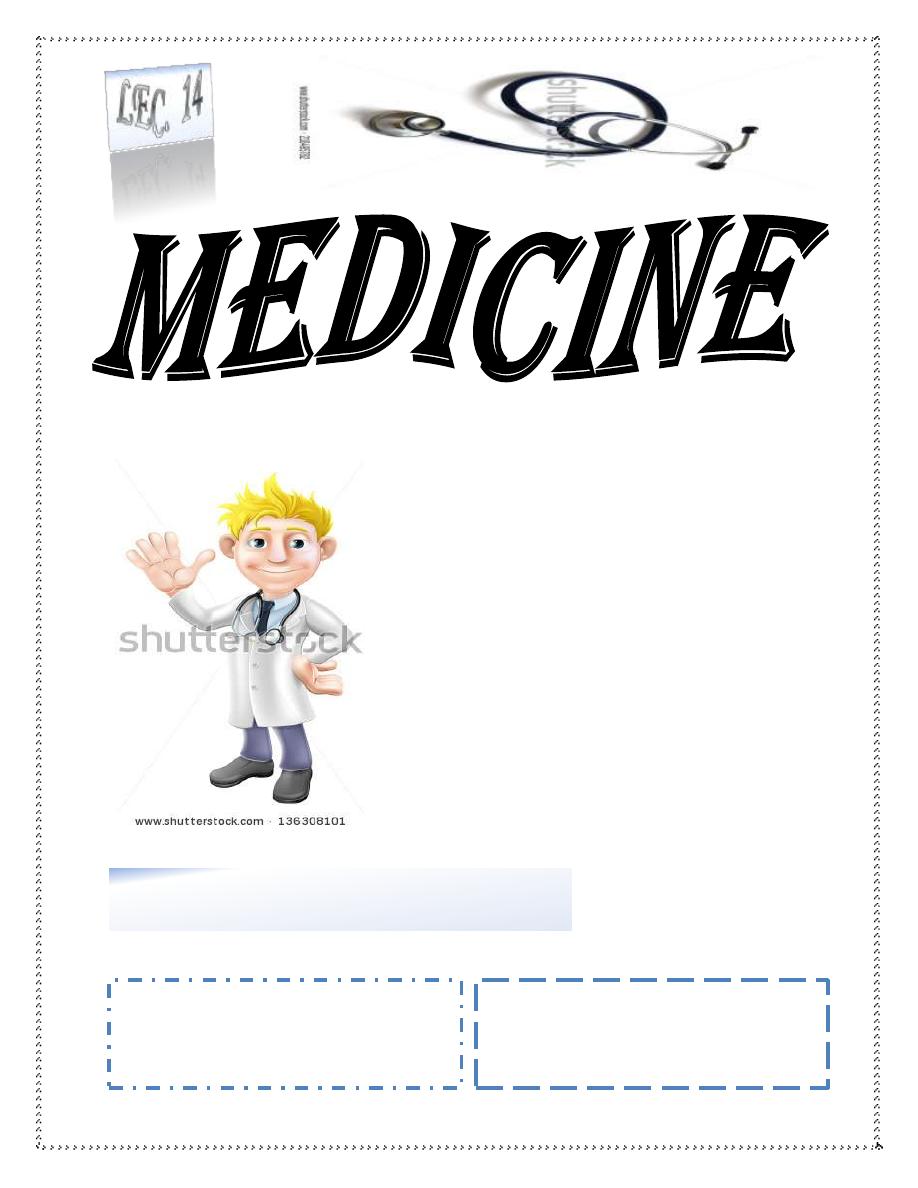
Dr. Ali A. Allawi
Lec. 3
Electrolyte Balance
Thurs
27 / 11 / 2014
مكتب اشور لالستنساخ
Published by : Ali Kareem
5102
-
5102

Electrolyte Balance Dr. Ali A. Allawi
27-11-2014
2
ELECTROLYTE BALANCE
DISORDERS OF POTASSIUM CONTENT AND CONCENTRATION
• The usual dietary intake varies between 80 and 150 mmol daily, depending
upon fruit and vegetable intake. Most of the body's potassium (3500 mmol
in an adult man) is intracellular. Serum potassium levels are controlled by :
• uptake of K
+
into cells
• renal excretion
• extrarenal losses (e.g. gastrointestinal)
Uptake of potassium into cells is governed by the activity of the Na
+
/K
+
-
ATPase in the cell membrane and by H
+
concentration. Uptake is stimulated
by :
Insulin
β-adrenergic stimulation
theophyllines
Uptake is decreased by : α-adrenergic stimulation
acidosis - K
+
exchanged for H
+
across cell membrane
cell damage or cell death - resulting in massive K
+
release
Hypokalemia
• Serum K
+
< 3.5 mEq /L
• Beware if diabetic
– Insulin gets K
+
into cell
– Ketoacidosis – H
+
replaces K
+
, which is lost in urine
• β – adrenergic drugs or epinephrine

Electrolyte Balance Dr. Ali A. Allawi
27-11-2014
3
Causes of hypokalaemia
Increased renal excretion
o Diuretics: thiazides loop diuretics
Increased aldosterone secretion
o Liver failure/ Heart failure/ Nephrotic syndrome /Cushing's syndrome
/Conn's syndrome/ ACTH-producing tumours
Exogenous mineralocorticoid
o Corticosteroids/ Carbenoxolone / Liquorice (potentiates renal actions
of cortisol)
Renal disease
o Renal tubular acidosis types 1 and 2/ Renal tubular damage (diuretic
phase) / Acute leukaemia / Cytotoxic
treatment / Nephrotoxicity / Amphotericin / Aminoglycosides
Release of urinary tract obstruction /Bartter's syndrome/ Liddle's
syndrome /Gitelman's syndrome
Reduced intake
o Intravenous fluids without K
+
Dietary deficiency
Redistribution into cells
o
β-Adrenergic stimulation / Acute myocardial infarction Beta-agonists:
e.g. fenoterol, salbutamol / Insulin treatment, e.g. treatment of diabetic
ketoacidosis /Correction of megaloblastic anaemia, e.g. B
12
deficiency
Alkalosis/ Hypokalaemic periodic paralysis
Gastrointestinal losses
o Vomiting / Severe diarrhoea /Purgative abuse / Villous adenoma
/Ileostomy or uterosigmoidostomy / Fistulae / Ileus/intestinal
obstruction
Clinical manifestations of Hypokalemia
Neuromuscular disorders
o Weakness, flaccid paralysis, respiratory arrest, constipation
Dysrhythmias, appearance of U wave
Postural hypotension
Cardiac arrest
Others
Treatment
o Increase K
+
intake, but slowly, preferably by foods

Electrolyte Balance Dr. Ali A. Allawi
27-11-2014
4
Treatment of hypokalaemia
Cause
dietary deficiency
• Increase intake of fresh fruit/vegetables or oral potassium
supplements (20-40 mmol daily) (Potassium supplements can cause
gastrointestinal irritation
Hyperaldosteronism, e.g. cirrhosis, thiazide therapy
• Spironolactone
• Co-prescription of a potassium-sparing diuretic with a similar onset
and duration of action
Intravenous fluid replacement
• Add 20 mmol/L of K
+
with monitoring
Hyperkalemia
Serum K+ > 5.5 mEq / L
Check for renal disease
Massive cellular trauma
Insulin deficiency
Addison’s disease
Potassium sparing diuretics
Decreased blood pH
Exercise causes K+ to move out of cells
Causes of hyperkalaemia
Decreased excretion
o Renal failure /* Drug:* direct effect on potassium
handling /Amiloride / Triamterene / Spironolactone /Aldosterone
deficiency/ Hyporeninaemic hypoaldosteronism (RTA type 4)/
Addison's disease/ ACE inhibitors*/ NSAIDs/ Cyclosporin treatment/
Heparin treatment Acidosis/* Gordon's syndrome
Increased release from cells (decreased Na
+
/K
+
-ATPase activity

Electrolyte Balance Dr. Ali A. Allawi
27-11-2014
5
o Acidosis/ Diabetic ketoacidosis/ Rhabdomyolysis/tissue damage
/Tumour lysis /Succinylcholine (amplified by muscle denervation)/
Digoxin poisoning Vigorous exercise (α-adrenergic; transient )
Increased extraneous load
o Potassium chloride Salt substitutes Transfusion of stored blood*
Spurious
o Increased in vitro release from abnormal cells Leukaemia
/ Infectious mononucleosis / Thrombocytosis
/ Familial pseudohyperkalaemia / haemolysis in syringe
o Increased release from muscles Vigorous fist clenching during
phlebotomy
Clinical manifestations of Hyperkalemia
Early – hyperactive muscles , paresthesia
Late - Muscle weakness, flaccid paralysis
Change in ECG pattern
Dysrhythmias
Bradycardia , heart block, cardiac arrest
Treatment of Hyperkalemia
•
Correction of severe hyperkalaemia
IMMEDIATE
Attach ECG monitor and IV access
Protect myocardium
– 10 mL of 10% calcium gluconate IV over 5 mins
– Effect is temporary but dose can be repeated after 15 mins
Drive K
+
into cells
– Insulin 10 units + 50 mL of 50% glucose IV over 10-15 mins
followed by regular checks of blood glucose and plasma K
+
– Repeat as necessary

Electrolyte Balance Dr. Ali A. Allawi
27-11-2014
6
– and/or correction of severe acidosis (pH < 6.9) - infuse
NaHCO
3
(1.26%)
– and/or salbutamol 0.5 mg in 100 mL of 5% glucose over 15
min (rarely used
LATER
Deplete body K
+
(to decrease plasma K
+
over next 24 h)
Polystyrene sulphonate resins 15 g orally up to three times daily with
laxatives
30 g rectally followed 3-6 hours later by an enema
Haemodialysis or peritoneal dialysis if the above fails
Calcium Imbalances
Most in ECF
Regulated by:
Parathyroid hormone
– ↑Blood Ca
++
by stimulating osteoclasts
– ↑GI absorption and renal retention
Calcitonin from the thyroid gland
– Promotes bone formation
– ↑ renal excretion
Hypercalcemia
Usually also see hypophosphatemia
Results from :
Hyperparathyroidism
Hypothyroid states
Renal disease
Excessive intake of vitamin D
Milk-alkali syndrome
Certain drugs

Electrolyte Balance Dr. Ali A. Allawi
27-11-2014
7
Malignant tumors – hypercalcemia of malignancy
Tumor products promote bone breakdown
Tumor growth in bone causing Ca
++
release
Effects :
Many nonspecific – fatigue, weakness, lethargy
Increases formation of kidney stones and pancreatic stones
Muscle cramps
Bradycardia, cardiac arrest
Pain
GI activity also common
Nausea, abdominal cramps
Diarrhea / constipation
Metastatic calcification
Hypocalcemia
Hyperactive neuromuscular reflexes and tetany differentiate it from
hypercalcemia
Convulsions in severe cases
Caused by :
Renal failure
Lack of vitamin D
Suppression of parathyroid function
Hypersecretion of calcitonin
Malabsorption states
Abnormal intestinal acidity and acid/ base bal.
Widespread infection or peritoneal inflammation

Electrolyte Balance Dr. Ali A. Allawi
27-11-2014
8
Diagnosis :
Chvostek’s sign
Trousseau’s sign
Treatment :
IV calcium for acute
Oral calcium and vitamin D for chronic
Done by
Ali Kareem
